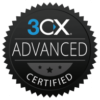In the ever-evolving landscape of business telephony, the release of 3CX Version 20 marks a significant milestone for the company. 3CX has made significant changes to their underlying architecture, as well as many very significant changes to how the phone system is configured including changes to administration, security, routing, groups (departments) and more. As the foremost third-party developer for 3CX addons, we have a unique perspective on this latest release of 3CX. If you are considering moving to 3CX V20, there are some things you should know to make the migration as pain-free as possible. The question we need to answer is whether now is the time to upgrade, and whether the changes are good, bad, or just different.
Preparing for the Upgrade: A VoIPTools Checklist
I spend a good portion of each day answering questions in the 3CX forums. One of the things that has become abundantly clear is the significant increase in the number of forum posts associated with this release. In my view far more posts than is typical of a new full release of 3CX. However, many, if not most, of the challenges customers are facing are the direct result of insufficient preparation. 3CX has been very clear about the steps you need to take BEFORE upgrading to V20, but it seems far too many people did not perform even the smallest amount of due-diligence before attempting the upgrade.
As shocking as this may sound, there is large portion of the 3CX customer base that turn on automatic updates in 3CX and let 3CX decide when and how to upgrade. This is a recipe for disaster. The only phone systems we configure for automatic updates are our test servers, because we want to find out what 3CX has changed (or broken) as soon as possible. We would NEVER, EVER configure 3CX for automatic updates on a production phone system. Nor would we ever upgrade 3CX to the latest service pack, let alone major version upgrade, without carefully reviewing 3CX recommendations, and only after testing the new release on a non-production server.
This careful approach to upgrades is not just about stability concerns (bugs) in the 3CX software. 3CX is actually remarkably successful in providing stable releases even in the early pre-production ALPHA editions. Nevertheless, 3CX has a very, very long history of releasing new full versions of the phone system that do not yet have feature-parity with the previous version of the phone system. Version 20 is no exception to this rule. Like other new full versions of 3CX in the past, V20 is missing some key feature that will not return until Service Pack 1, and may not be restored until much later. Some of the omissions include hotdesking, scheduled reports, and several other features. It would be very painful to discover AFTER an upgrade, that a key feature (or two) that your business depends on is not yet available in the initial production release. With 15+ years of experience implementing 3CX, we don’t even consider upgrading to a new version of 3CX before Service Pack 2, and frequently not until Service Pack 3 or later. The timeline for the release of Service Pack 3 is often several months after the initial release. My advice – DO NOT be an early adopter of a new 3CX release. Let others find the issues and go through the pain. Patience is the watch-word when it comes to 3CX.
What about new customers purchasing 3CX today? The long-standing 3CX policy is to only offer the latest release (V20). They will not allow you to purchase a new V18 license, nor will they allow you to downgrade your license key to V18 — at least, not without making a huge stink about it and probably not even then. Your only hope would be to explain that your business depends on one of those features that was available in V18 but has not yet been made available in V20. Be prepared for a long negotiation with your 3CX sales representative.
So, you have made the business decision to upgrade 3CX to V20. What do you need to know? Below are some of the things you need to consider BEFORE upgrading to 3CX version 20:
System and Network Readiness: Ensure your 3CX server hardware meets the new minimum system requirements of 2 GB RAM and 2 vCPUs. Previous versions of 3CX could be installed on a server with one vCPU. That is no longer the case. If you try to upgrade an existing 3CX server running on a single-vCPU server, the upgrade will fail – period – end of story. Happily, for those people hosting their 3CX server on Amazon Lightsail, Amazon has increased their smallest server CPU count to two!
For on-premises installations, configuring Split DNS is now essential for seamless operation. If you don’t know what Split DNS means, you better find out before you upgrade. Essentially it means that when your workstation is on the same local network as your 3CX server, the 3CX domain name (example: mysubdomain.3cx.us.com) needs to resolve (ping) to the local IP address of your 3CX server, and when you are connecting to 3CX from a different network (over the internet for example) the FQDN must resolve to the public IP address. Make sure you handle this before you upgrade!
Assign a System Owner: A crucial initial step is to designate a System Owner with a unique email address. I cannot tell you how many times I have seen people in the forums skip this step. To all – this is REQUIRED. Further, don’t gloss over the importance of ensuring each and every extension (user) is configured with a UNIQUE email address. You can no longer share a common email address with multiple extensions. Perhaps the easiest way to get around this requirement is to create alias email addresses that ultimately point to the same email account. But hear me now and listen to me later – every extension must have a unique email address. By the way, the trusty and loved management console no longer exists. That’s right, you now administer your 3CX server using the 3CX web client!
Embrace Departments: Version 20 introduces Departments to replace Groups (same thing different name), offering a more organized and flexible way to manage your setup. Once you upgrade, you will need to move your Queues, IVR, and Ring Groups accordingly to the appropriate groups. Why the change? 3CX is working toward supporting multi-tenancy (at least for smaller implementations of 3CX). This release of 3CX still has some omissions that make multi-tenancy impractical, but this is the first real move in that direction.
Configure Departmental Office Hours: With the move away from global office hours, it’s important to set up department-specific operational times, enhancing the customization of your communication system. This is perhaps one of the most wished-for new feature — the ability to have different work hours and holidays per group (oops “Department”). For example, if you have an office in the USA and another office in Europe both sharing the same phone system (like us USA and India), you will obviously have different work hours and holidays. Now that scenario is supported in 3CX. That’s awesome, but you need to plan for, and allocate some significant hours to implement these changes after the upgrade.
Understand Rights and Roles: Familiarize yourself with the reset of the new user roles and rights to ensure a smooth transition. Changes to user permissions has generated a lot of discussion on the forums… dare I say one of the least appreciated changes in V20. I assume how user permissions are grouped in V20 will change over time. Right now, I’m seeing a fair number of people that don’t like the changes.
Call Visibility Adjustments: Adjust call visibility settings to ensure team members have access to the necessary calls from different departments. A lot has changed in 3CX with regard to permissions and former global settings. Pay close attention to this aspect of your upgrade – most of the upgrade pain you will experience will be associated with departments and how global settings (inbound rules for example) are now associated exclusively with departments.
New Windows softphone: Get to know the new Windows softphone, which replaces the former desktop app. For those of you that appreciate the desktop app, be glad it still exists (3CX has been trying to kill it for close to a decade). It continues to be reliable, and offers a small footprint, but don’t expect to see feature parity with previous versions of the desktop or web client. They have kept this client around purely because there are a couple of existing features that are only possible with a desktop application. They have stripped this client down to only include basic softphone features.
Exercise Patience: As I mentioned previously, some features, like Hot Desking and Scheduled Reports, will be reintroduced in later service packs. Take the time to identify all your key features and then verify they made it into the initial V20 release. If these are critical to your operations, consider the timing of your upgrade carefully.
VoIPTools Compatibility: We are excited to announce that we successfully upgraded all our tools to support V20 by the time 3CX published Release Candidate 2. However, for the first time in 15+ years, 3CX has made some breaking changes that we couldn’t work around. Our “3CX Recording Beep”, “3CX Agent Greeting”, and “3CX Barge Messages” tools each depend on the same 3CX barge API. Unfortunately, 3CX has removed the ability to barge into a phone call using an IVR, Call Flow Designer application or even a dummy user extension. The ability to barge into a call using an IVR extension is integral to the operation of these tools. If these tools are important to your business, you will need to wait to upgrade 3CX to V20 until 3CX gets around to fixing their barge API. We opened a ticket with 3CX within days of the first ALPHA release of V20. We will keep you informed as we get more information.
Navigating the Upgrade
Trial Installation: Take advantage of a two-month hosted/self-hosted/local install trial to familiarize yourself with Version 20 and ensure your configuration is ready for the upgrade.
Strategic Upgrade Path: Follow a strategic approach to upgrading, including ensuring your system meets all prerequisites and understanding the changes to features and functionalities.
Stay Informed: Keep an eye on updates from 3CX and VoIPTools for the latest on feature rollouts and additional guidance on making the most of Version 20.
Conclusion
Upgrading to 3CX Version 20 is more than just a technical process; it requires thoughtful consideration of how you are going to implement many new mandatory changes. This upgrade is unlike any previous upgrade I have experienced in the last 15 years. You cannot expect to simply perform a successful upgrade and be done. This time, the upgrade is going to require some work on your part post-upgrade. At VoIPTools, we’re committed to supporting you through every step of this journey, providing the insights and tools you need to harness the full potential of Version 20. By preparing thoroughly and embracing the innovative features and changes this version brings, you can elevate your business communication to new heights. Our tools are available today for V20.


